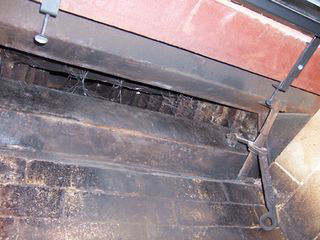
by blogediter | Mar 9, 2018 | Chimney Plugs
Damper Handle
Q: Jason, Most of the diagrams on the Chimney Balloon.us show fireplace dampers with the handle in the middle of the damper door. On my fireplace, I have the damper handle way off to the right side (see the two attached pictures with the damper open and damper closed). Does this make a difference? Should I still install a Chimney Balloon above my damper? I measured the area above the damper and it is 11″ deep and 30″ across – TY
A: Dear TY, Thank you for the two damper photos. The opening and closing mechanism are unique on this fireplace damper. I have seen this type of damper before, but have never take a photo of it. I can tell by the cobwebs hanging in your open flue (in the open damper photo) that you must not use this fireplace very much.
In this particular application, I would recommend that you install the Chimney Balloon above the damper. The handle and other damper hardware are on the way below the damper and it looks like the firebox opens to the hearth almost immediately below the damper so there is not much lintel there.
Since your measurements above the damper are 30″x11″ and it looks like the flue stair steps smaller as it goes upward I would go with a 33×12 Chimney Balloon in this fireplace flue. You can always go a little larger (up to 6″ or so) in the Chimney Balloon size you purchase, just never buy one smaller than your measurements. – Jason
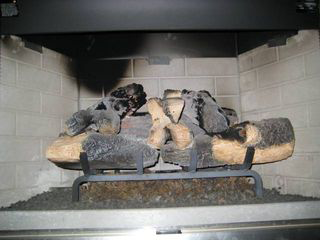
by blogediter | Mar 7, 2018 | Gas Logs
Ventless gas logs
Q: Jason, Vent-less Gas logs are appealing to me because they put all of their heat into the house and are efficient. However, they also concern me because they also put all of their combustion gasses into the room. Wouldn’t this cause high levels of CO and CO2.
I could opt to put in vented gas logs since I am installing them in a wood fireplace that already has a chimney and flue, but the efficiency will not be there since most of the heat will go up the flue with a vented unit. What is your opinion? – RW
A: Dear RW, You have stumbled upon a debate that has raged in the hearth industry for decades. Before 1980 Vent-less gas logs were undeniably dangerous, but there have been improvements since then. Ventless gas log manufacturers swear by their newer products and say they are safe and do not elevate CO or CO2 levels. They say they even build in CO sensors that will shut the vent free heating device off if it malfunctions and causes a CO backup.
On the other side, you have the EPA and health professionals that say they have nothing but trouble with vent free gas logs since they introduce high levels of water vapor and generally decrease air quality in homes. They have not really been able to point to solid evidence of this, but rather just state it from experience.
The New Impartial Study on Vent-less Gas Logs:
The University of IL (Urbana/Champagne) recently introduced results of a study they conducted on 30 homes over a 3 years period to see how vent-free gas appliances do affect the homes air quality. The complete study is available online, but I will give you a brief summary of what I found most interesting about it since I saw a presentation on this study at the ACI show in Kansas City. It was presented by Paul F., one of the main researchers to the U of IL study.
- NO2 is the gas most likely to exceed acceptable levels when operating a vent free device.
- The safety shutoff sensor on vent free units does not sense for NO2 levels.
- CO occasionally exceeded the 8hr maximum in tests where they were a long continuous run time or in a tightly enclosed space.
- Relative humidity is more likely to be a problem further from the fireplace since those areas will be cooler.
- The EPA says “Avoid installing unvented (or “vent-free”) space or water heating appliances“
Now we all know that Carbon Monoxide (CO) is not something we want in our homes but (NO2) Nitrogen Dioxide was new to me so I had to look up the side effects. Quite frankly, I found the side effects to be pretty scary.
The researcher that did this presentation was very impartial and factual in his presentation. However, at the Q&A session of the audience members put him on the spot and asked: “Would you personally install a vent free heating appliance in your home?” You could tell that this question made Paul nervous, but he answered truthfully and addressed the fact that the audience member was only asking his personal opinion and not anything related to the research (this was very wise to point out). His answer was “No, I would not.”
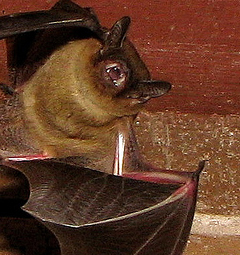
by blogediter | Mar 5, 2018 | Chimney Plugs
Bat in Chimney
Q: Jason, I have quite a few bats in my chimney. I had one sneak down through the damper last night and start flying around the house until I whacked him. This bat thing is not cool! Will a Chimney Balloon keep them out of the house and how do I get the bats out of the chimney? – BG
A: Hi BG, I have had to whack a few interior bats in my day too. The little critters can get through a gap as small as 3/8 inch so they can get in about anywhere. A fireplace chimney damper is often as good of a place as any to gain entry to your home since there are often gaps in the damper door once they start warping from the heat.
Here is what you do… Get a Chimney Balloon installed just above your damper door and seal the flue nice and tight and inflate the Chimney Balloon nice and tight. Then go to the roof (if you have access to the chimney and take a cloth bag with some moth balls in it and toss it down the chimney so it lands on the top of the Chimney Balloon. The mothballs will annoy the bats and they will fly up and out to get away from it. Make sure you don’t just do the mothballs without the Chimney Balloon though since you could end up coaxing them right into the house if you don’t have the chimney sealed off above the hearth.
Since the Chimney Balloon is in there tight the smell from the mothballs should stay in the chimney not enter the home.
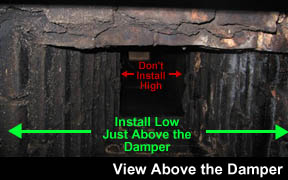
by blogediter | Mar 2, 2018 | Chimney Plugs
Smoke Chamber Install
Q: Jason – I previously ordered a 9X9 Chimney Balloon and it works fine for the flue (size 8″ square). What I don’t like about it is that the flue is about 5″ higher than the 12″ X 16″ smoke chamber. So when I place the 9×9 Chimney Balloon in the flue I have to really reach to get a good fit. Instead of getting your Chimney Balloon extension rod I figure it would be best to try and get another him Chimney Balloon to fit the 12 X 16 area above the damper. As I mentioned the 12 X 16 area (smoke chamber?) has only a 5-inch height then the flue begins. So if I understand correctly order a custom 12 X 18 and this would seal the area above my damper (12 X 16 X 5) Thanks, DT
A: Hi DT, It is true that a lower install location makes putting in a Chimney Balloon much easier, so I agree a larger Chimney Balloon for the smoke chamber is the way to go.
A custom 12×18 Chimney Balloon would work well for a 12″x16″ area. Remember, a Custom Chimney Balloon requires a 14 day build time, but it is worth the wait to get the correct size. You could consider a stock 24×12 Chimney Balloon, but I am concerned there will be too much extra Chimney Balloon material if you went with this size. If you get a Chimney Balloon that is more than 6″ oversize the extra material can make the install more difficult.
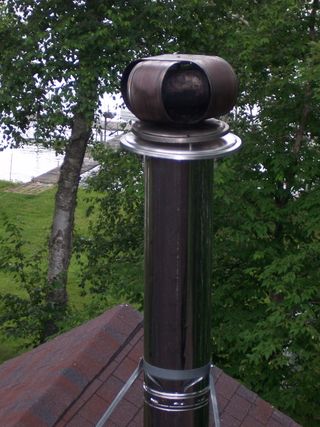
by blogediter | Feb 28, 2018 | Chimney Problems
Vacustack
Q: Jason – I cleaned our fireplace hearth several weeks ago and still notice a smoke smell in the living room. I did the vinegar fireplace smell deodorizer trick that you suggested in another article and had little results. On windy and/or rainy days, the smell is worse. I am thinking of purchasing a special chimney cap, such as a vacu stack, which would prevent downdrafts especially when a fire is burning. That would solve back-drafting when the fireplace is lit.
I am wondering, in addition to the cap, if the Chimney Balloon would stop the odor from coming into the room especially days after the fire is out. Just wanted your opinion on that. I also measured just above the damper and came up with 36″ X 14″. Which Chimney Balloon would I need? – PM
A: Dear PM, In order for the vinegar and baking soda trick to have a lasting effect in neutralizing the smell coming from the chimney the trick, is to seal the flue first so more creosote laced air doesn’t descend the flue into the room.
The 36×15 Chimney Balloon will fit well in a 36×14 flue and it will help you stop the smelly air from descending the chimney. It will all but eliminate the fireplace smoke smell as long as you install it in a low location (like by the damper).
The vacu stack (photo of one above) is great if your fireplace belches smoke during your burn from a deflecting outside downdraft that is pushing down at the chimney. This can sometimes be an issue if the chimney top is not above the roof-line or if trees deflect winds at the chimney.
If the issue is due to limited stack effect in your home then a vacu stack may not work so well. A fireplace that is smokey during the burn can have any number of issues causing the problem, but your Chimney Professional will likely be able to diagnose the issue.




